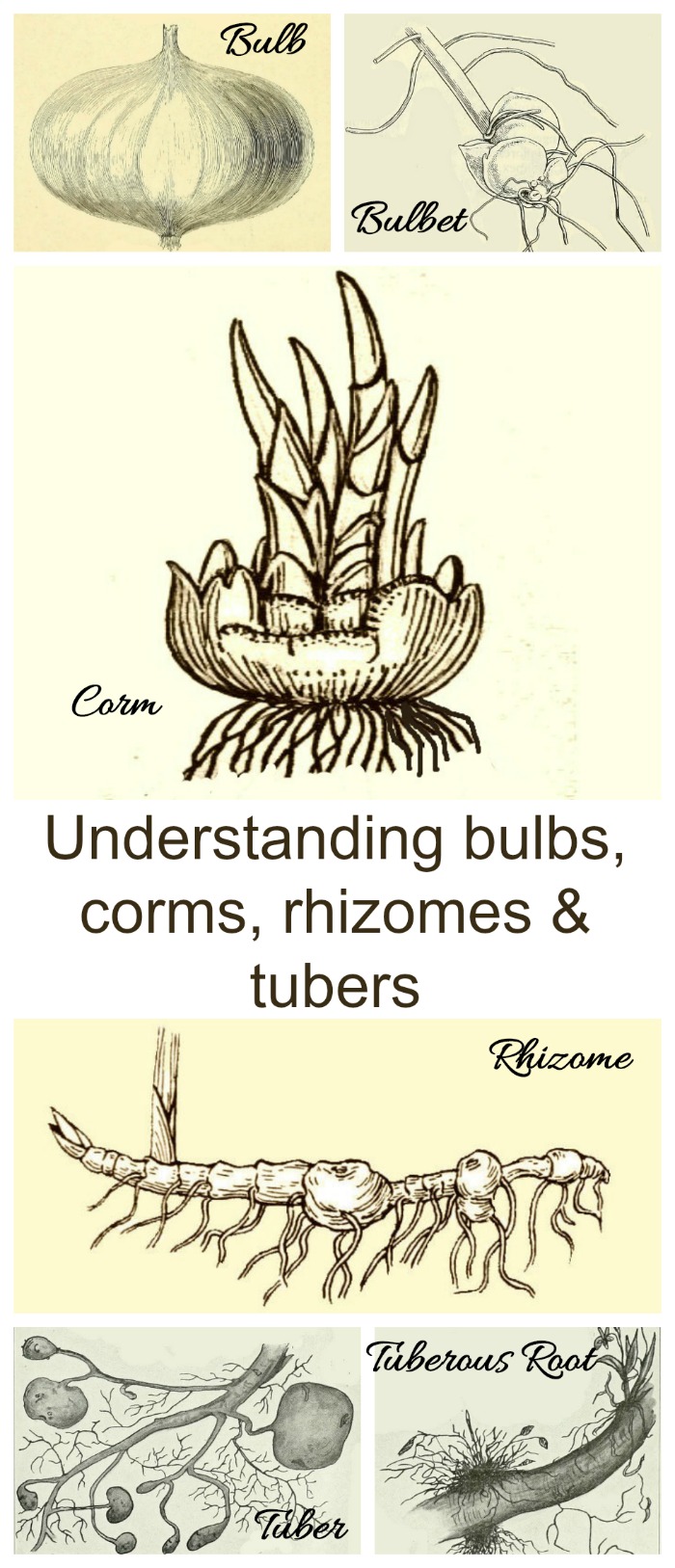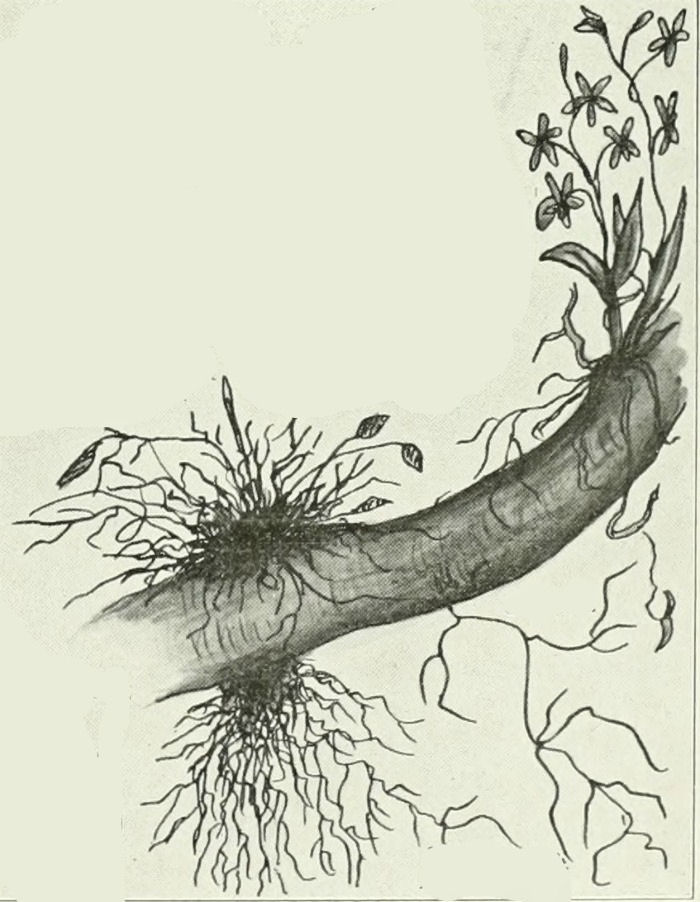How well do you know your flower bulb types? Do the words bulbs corms rhizomes tubers and bulbets seem like Greek to you? Read on and you find out what you need to know to be a bulb expert.
Flowering bulbs are some of the easiest plants to grow.
Some of the spring flowering bulbs, such as tulips, crocuses and daffodils will give you weeks for flowering long before other perennials have started to show up.
You may think that he various bulb types are pretty much the same – Just plant them and watch them grow.
But there are some things that you need to know to get the most out of your flower bulbs.
Flower Bulb Types
A true bulb is an underground storage structure. It contains a food supply to get it started and the genetic starting material to produce more plants.
There are several types of bulbs but only one true bulb.
Many people mistakenly refer to all plants with a fleshy underground storage as a bulb, but this is not correct. The various flower bulb types- bulbs corms rhizomes tubers and tuberous roots – are better described as geophytes rather than lumping they all under the term bulbs.
Differences between Bulbs Corms Rhizomes Tubers
Bulbs
A true bulb consists of a series of fleshy layers that store the food for the plant that will develop from the bulb. It has a series of roots at the base of the plant that it uses to absorb nutrients to help it grow.
The center tip of the bulk is the area where the leaves and new plant will emerge.
True bulbs are normally perennials. They grow and flower for a while and then become dormant, die back to the ground and then grow again the next year. Most bulbs are spring and summer flowering.
A few re-bloom into the fall months, too.
Fall is the time to plant spring flowering bulbs for best effect.
True bulbs come in two types – Tunicate bulbs and imbricate bulbs. The main difference between the two is the tunicate bulbs have the outer skin.
Tulips are tunicate bulbs. Imbricate bulbs don’t have the paper covering and should stay moist before planting. Lilies are a good example of imbrication bulbs.
It is best to plant his type of bulb in the fall so that it has time to develop roots.
Examples of true bulbs are:
- Onions
- Tulips
- Some forms of Lilies
- Daffodils
- Garlic.
- Hyacinths
- Snowdrops
- Allium
- Amaryllis
- Narcissus.
The main problem with growing bulbs in a cottage garden is dealing with squirrels. See how to keep squirrels from digging up bulbs here.
Bulbets
Many flower bulb types produce bulbets. Technically a bulbet is a tiny baby bulb that grows next to the mother bulb.
Daffodils are a good example of bulbs that produce bulbets and that is why you see your patch of them spreading each year.
Other plants, like tiger lilies will produce tiny bulbs that grow on the stem of the plant. Also, plants in the onion family, such as garlic or allium will form bulbets in their flower heads.
Understanding Geophytes – bulbs corms rhizomes tubers
Corms
A corm has a solid mass of stem tissue, rather the the rings of leaves that the bulbs have. They look similar to bulbs but are solid at their core. If you cut them apart, you will not find any rings at all.
They are thickened at the base of the stems and have 1-2 buds at the apex. Smaller cormlets will often grown around the base of the corm.
Examples of corms are:
- Crocus
- Gladiolus
- Greesia
- Gierama
- Romulea
- Bananas
- Liatris
- Jack in the pulpit
- Elephant ear. Not strictly a corm since it will grow from just a piece, but is treated like a corm. Some growers classify them as tubers.
- Some types of begonias.
Rhizomes
Most bulb types grow upward, but not so with rhizomes. They feature swollen stems which grow horizontally near the soil surface and produce lots of buds along the rhizomes.
Old stands of irises often have the rhizomes pushing right through the soil. I had a spindly iris patch around the well in my front yard that got literally no water. I dug them up and planted them throughout my garden beds and they flourish now.
Examples of Rhizomes include:
- cannas
- Calla Lily
- Bearded irises
- Ginger
- Asparagus
- Lily of the valley
- Bamboo
- Some fern types
- Chinese lanterns
- Agapanthus
- Turmeric
- Water lilies
Even some weeds such as Japanese knotweed grow from rhizomes. They can take over a garden in a single season if you are not careful to keep on top of them.
Tubers
A tuber is actually a swollen stem that has growth nodes and eyes on it. It could accurately be described as the swollen tip of a rhizome.
Tubers lack a basal plate like corms have. They also do not multiply and form more tubers.
Most tubers just get larger each year. Some plants also have tuberous roots. These thickened roots hold the food source for the plant. Tuberous begonias are a good example.
You can propagate tubers by planting just a piece of it with some healthy eyes. Many people do this with potatoes.
Examples of tubers and tuberous roots are:
Tuberous Roots

In addition to plants growing from actual tubers, some plants grow from tuberous roots. These thickened roots hold the food source for the plant.
Tuberous roots are similar to Rhizomes. The exception is that white it is a true root, it has no tap root.
Examples are:
- Clivia
- Dahlias
- Sweet potato
- Tuberous Begonias
- Daylilies
Even though each of these types of geophytes – bulbs corms rhizomes tubers – grows differently than the others, they do have two things in common – They have all adapted to growing well through long spells of drought and they are basically storage organs.
Share this post about flower bulbs types on Twitter
If you enjoyed this post about understanding the different bulb types, be sure to share it with a friend. Here is a tweet to get you started:
Bulbs, corms, rhizomes and tubers may all seem similar but there are many ways in which they differ. Head to The Gardening Cook to find out the differences and how to grow and plant them. Click To TweetI hope you have enjoyed my explanation of the various types of flower bulb types. Which do you grow in your garden?

Elizabeth
Saturday 22nd of October 2022
I have a question? after Calla Lillies have finished flowering, do you have to dig up the tubers, and put them in a dry area, to keep the roots from rotting, OR doesn't it really matter?
I have left my Calla Lillies in the ground, and this SPRING ONLY 2x plants has just started to pop out of the ground. I live in Carrum Downs, Melbourne VIC, and we have had so much rain from Autumn to Spring, and I am thinking that this is why they haven't started sprouting yet?
Please help me at what I should do?
Thanks
Liz
Carol Speake
Saturday 22nd of October 2022
I'm not familiar with Melbourne's weather and how cold it gets, but calla lilies can only be left in the ground in zones 8-10. Below those zones, they have to be dug up for the cold weather. Calla lilies don't mind wet soil, so that is probably not the reason.
Sofia
Tuesday 2nd of March 2021
This is lovely and super useful!
Emma
Monday 22nd of April 2019
Is the Easter Lily a tuberous root?
Carol
Monday 22nd of April 2019
The Easter lily is a bulb.